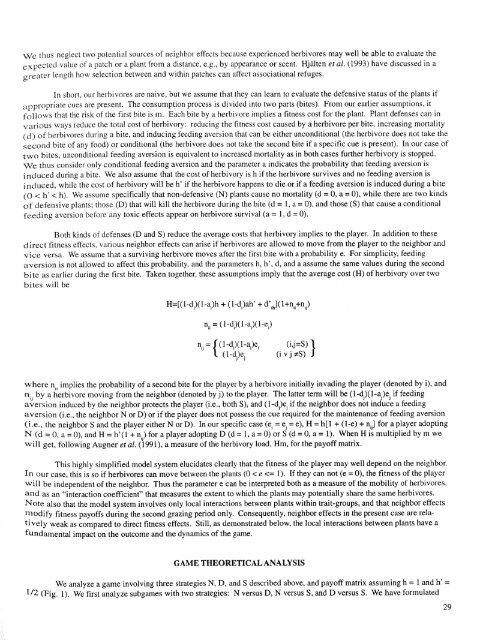View or print this publication - Northern Research Station - USDA ...
View or print this publication - Northern Research Station - USDA ...
View or print this publication - Northern Research Station - USDA ...
Create successful ePaper yourself
Turn your PDF publications into a flip-book with our unique Google optimized e-Paper software.
We tlhus neglect two potential sources of neighb<strong>or</strong> effects because experienced herbiv<strong>or</strong>es may well be able to evaluate the<br />
expected value of a patch <strong>or</strong> a plant from a distance, e.g., by appearance <strong>or</strong> scent. Hjfilten et al. (1993) have discussed in a<br />
greater length how selection between and within patches can affect associational refuges.<br />
In sh<strong>or</strong>t, our herbiv<strong>or</strong>es are naive, but we assume that they can learn to evaluate the defensive status of the plants if<br />
appropriate cues are present. The consumption process is divided into two parts (bites). From our earlier assumptions, it<br />
follows that the risk of the first bite is m. Each bite by a herbiv<strong>or</strong>e implies a fitness cost f<strong>or</strong> the plant. Plant defenses can in<br />
various ways reduce the total cost of herbiv<strong>or</strong>y: reducing the fitness cost caused by a herbiv<strong>or</strong>e per bite, increasing m<strong>or</strong>tality<br />
(d) of herbiv<strong>or</strong>es during a bite, and inducing feeding aversion that can be either unconditional (the herbiv<strong>or</strong>e does not take the<br />
second bite of any food) <strong>or</strong> conditional (the herbiv<strong>or</strong>e does not take the second bite if a specific cue is present). In our case of<br />
two bites, unconditional feeding aversion is equivalent to increased m<strong>or</strong>tality as in both cases further herbiv<strong>or</strong>y is stopped.<br />
We thus consider only conditional feeding aversion and the parameter a indicates the probability that feeding aversion is<br />
induced during a bite. We also assume that the cost of herbiv<strong>or</strong>y is h if the herbiv<strong>or</strong>e survives and no feeding aversion is<br />
induced, while the cost of herbiv<strong>or</strong>y will be h' if the herbiv<strong>or</strong>e happens to die <strong>or</strong> if a feeding aversion is induced during a bite<br />
(O < h' < h). We assume specifically that non-defensive (N) plants cause no m<strong>or</strong>tality (d - 0, a - 0), while there are two kinds<br />
of defensive plants; those (D) that will kill the herbiv<strong>or</strong>e during the bite (d = 1, a - 0), and those (S) that cause a conditional<br />
feeding aversion bef<strong>or</strong>e any toxic effects appear on herbiv<strong>or</strong>e survival (a - 1, d = 0).<br />
Both kinds of defenses (D and S) reduce the average costs that herbiv<strong>or</strong>y implies to the player. In addition to these<br />
direct fitness effects, various neighb<strong>or</strong> effects can arise if herbiv<strong>or</strong>es are allowed to move from the player to the neighb<strong>or</strong> and<br />
vice versa. We assume that a surviving herbiv<strong>or</strong>e moves after the first bite with a probability e. F<strong>or</strong> simplicity, feeding<br />
aversion is not allowed to affect <strong>this</strong> probability, and the parameters h, h', d, and a assume the same values during the second<br />
bite as earlier during the first bite. Taken together, these assumptions imply that the average cost (H) of herbiv<strong>or</strong>y over two<br />
bites will be<br />
H=[(1-di)(1-ai)h + (1-di)ah' + d'ih](1 +nii+nij)<br />
ni_= (1-d,)(1-a)(1-e)<br />
nij = { (1-di)(1-ai)ei (i,j=S) }<br />
(1-dj)ej (i v j aS)<br />
where n_ implies the probability of a second bite f<strong>or</strong> the player by a herbiv<strong>or</strong>e initially invading the player (denoted by i), and<br />
n_j by a herbiv<strong>or</strong>e moving from the neighb<strong>or</strong> (denoted by j) to the player. The latter term will be (1-d)(1-a)ej if feeding<br />
aversion induced by the neighb<strong>or</strong> protects the player (i.e., both S), and (1-d)e if the neighb<strong>or</strong> does not induce a feeding<br />
aversion (i.e., the neighb<strong>or</strong> N <strong>or</strong> D) <strong>or</strong> if the player does not possess the cue required f<strong>or</strong> the maintenance of feeding aversion<br />
(i.e., the neighb<strong>or</strong> S and the player either N <strong>or</strong> D). In our specific case (ei = e. l = e), H = h[1 + (l-e) + n_j]f<strong>or</strong> a player adopting<br />
N (d = 0, a = 0), and H = h'(1 + nij)f<strong>or</strong> a player adopting D (d = 1, a = 0) <strong>or</strong> S (d = 0, a = 1). When H is multiplied by m we<br />
will get, following Augner et al. (1991), a measure of the herbiv<strong>or</strong>y load, Hm, f<strong>or</strong> the payoff matrix.<br />
This highly simplified model system elucidates clearly that the fitness of the player may well depend on the neighb<strong>or</strong>.<br />
In our case, <strong>this</strong> is so if herbiv<strong>or</strong>es can move between the plants (0 < e
















